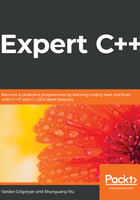
Introduction to Building C++ Applications
Programming languages differ by their program execution model; the most common are interpreted and compiled languages. Compilers translate source code into machine code, which a computer can run without intermediary support systems. Interpreted language code, on the other hand, requires support systems, interpreters, and the virtual environment to work.
C++ is a compiled language, which makes programs run faster than their interpreted counterparts. While C++ programs should be compiled for each platform, interpreted programs can operate cross-platform.
We are going to discuss the details of a program-building process, starting with the phases of processing the source code – done by the compiler- and ending with the details of the executable file (the compiler's output). We will also learn why a program built for one platform won't run on another one.
The following topics will be covered in this chapter:
- Introduction to C++20
- Details of the C++ preprocessor
- Under the hood of the source code compilation
- Understanding the linker and its functionality
- The process of loading and running an executable file